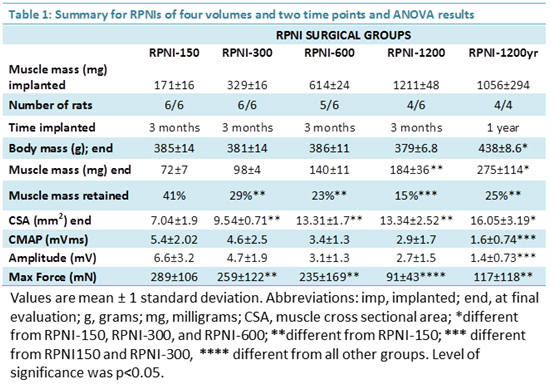Back to 2017 Annual Meeting Program
Muscle Graft Volume Implanted in Regenerative Peripheral Nerve Interfaces Influences Electrical Signal Transduction
Yaxi Hu, MD; Alixandra L VanBelkum, BA; Ian C Sando, MD; Racquel Sohasky, MD; Jana D Moon, BS; Stephen WP Kemp, PhD; Paul S Cederna, MD; Melanie G Urbanchek, PhD
University of Michigan, Ann Arbor, MI
Introduction: Regenerative Peripheral Nerve Interfaces (RPNIs) for interfacing to prostheses are formed by combining biology, biomedical abiotic products, muscle regeneration, nerve reinnervation, and tissue revascularization. An RPNI unit is a small muscle graft which is moved to the end of a transected residual nerve. The nerve fascicle is implanted / neurotized into the grafted muscle and electrodes are implanted with the muscle graft. Standard RPNI small muscle grafts have weighed approximately 150 mg with dimensions of 3 cm long by 1 cm diameter. In rat studies, RPNIs maintained muscle volume and signaling capacities for at least 9 months once healing processes stabilized at 3 months post implant. Though small muscle grafts conserve skeletal muscle, there are advantages to grafting larger volumes. Our purpose was to evaluate RPNI signaling capacity with respect: a) to increasing grafted skeletal muscle volume and b) to time of implantation.
Methods: F344 male rats (n=30) were assigned to 1 of 4 groups defined by RPNI muscle graft volume: 150mg (RPNI-150), 300 mg (RPNI-300), 600 mg (RPNI-600) or 1200 mg (RPNI-1200). Each RPNI consisted of a semimembranosus allograft to the upper thigh and neurotized by the transected peroneal nerve. All grafts were 3 cm in length. Group 1-4 RPNIs recovered for 3 months while a second 1200 mg group 5 (RPNI-1200yr) recovered for 1 year post-surgery. Compound muscle action potential (CMAP), RPNI contractile force, and RPNI histology were evaluated.
Results: All rats were healthy with RPNIs that were well vascularized and responded to stimuli applied to the implanted peroneal nerve. Data are summarized in Table 1. At evaluation, RPNIs of heavier graft volume still weighed more than the lighter RPNIs; however, heavier grafts retained less of their original muscle mass (Fig 1). Signaling capacities or the magnitude of electrophysiology (CMAP) and force measurements were inversely related to the volume of the muscle graft. Extending recuperation time for large volume grafts did not improve signaling.
Conclusions: RPNIs with muscle grafts weighing between 150 and 300 mg are optimal for signal production in the rat model. One year for recuperation did not benefit RPNIs implanted with heavier grafts.

Back to 2017 Annual Meeting Program
